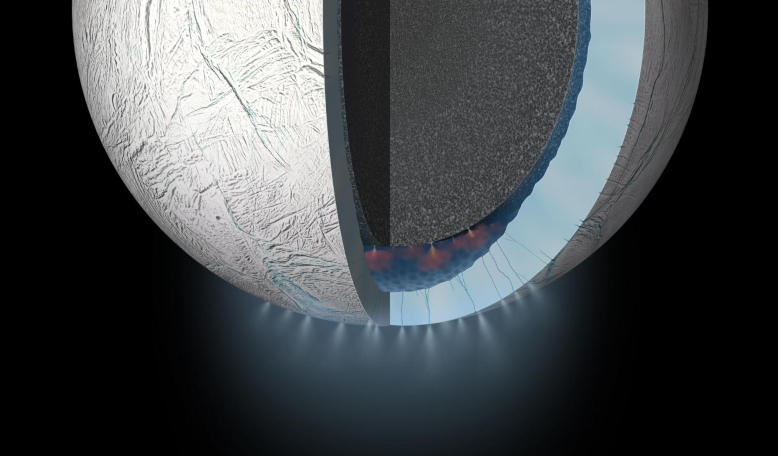Searching for life in the subsurface seas of Enceladus, Saturn’s sixth-largest moon, just got a boost, as a study of gases and frozen sea spray released through cracks in the moon's icy surface points to evidence of hydrothermal vents on the seafloor, and an interior more complex than previously thought.
Water-rich plumes venting from the moon’s south polar region were first spotted in 2005 when NASA’s Cassini spacecraft made its tour of the gas giants and some of their moons. Sights that were last seen in situ by the Voyager craft in the 1980s.
Scientists had long suspected that the ocean below Enceladus's icy exterior could harbour the ingredients for life, but last year, a new analysis of data collected by the mission revealed the presence of silica, nitrogen and oxygen in the plumes – the latter two being organic compounds that play a key role in producing amino acids.
Researchers had detected other organic molecules coming from the icy moon before, but this was the first time anyone has detected them dissolved in the water.
Now a team at the Southwest Research Institute, Texas has developed a new geochemical model that reveals that carbon dioxide (CO2) from within Enceladus may be controlled by chemical reactions at its seafloor; results that build on previous studies suggesting chemically complex processes are at work on this small icy world.
"Based on our findings, Enceladus appears to demonstrate a massive carbon sequestration experiment," said SwRI's Dr. Christopher Glein, lead author of a paper in Geophysical Research Letters outlining the research.
Sequestration is the process of removing a chemical from its environment and storing it away/using it in another organic or physical structure.
“Using two different data sets, we derived CO2 concentration ranges that are intriguingly similar to what would be expected from the dissolution and formation of certain mixtures of silicon- and carbon-bearing minerals at the seafloor,” Glein says.
Results that point to hydrothermal vents at work on Enceladus’s seafloor.
Again, its not the first time that hydrothermal vents on Enceladus has been put forward. Past research into the grains of silica – the form of silicon that is commonly found in quartz sand on Earth – analysed in Cassini data, also led scientists to the same suggestion; that the grains most likely formed when hot water carrying dissolved minerals emerged from the seafloor into the much cooler ocean - much the way hydrothermal vents deep in the oceans work.
This new research by the Southwest Research Institute helps cement this hypothesis.
"Distinct sources of observed CO2, silica and H2 imply mineralogically and thermally diverse environments in a heterogeneous rocky core," Glein said. "We suggest that the core is composed of a carbonated upper layer and a serpentinised interior."
Serpentine minerals comprise of a group of hydrous magnesium-rich silicate minerals) that form when other ultramafic rocks – rocks with a very low silica content – undergo hydrothermal metamorphism, while carbonates commonly occur as sedimentary rocks such as limestone on Earth.
Glein and colleagues say that chemical reactions with iron deep in Enceladus’ core is creating molecular hydrogen (H2). Then hydrothermal activity bursting through quartz-bearing carbonated rocks produces silica-rich fluids.
These rocks also have the potential to influence the CO2 chemistry of the ocean via low-temperature reactions involving silicates and carbonates at the seafloor.
Although hard evidence of the presence of microbial life in the ocean of Enceladus is still lacking, the growing evidence for chemical disequilibrium because of a heterogeneous core, “offers a tantalising hint that habitable conditions could exist beneath the moon's icy crust,” concluded SwRI's Dr. Hunter Waite, principal investigator of Cassini's Ion Neutral Mass Spectrometer (INMS).











